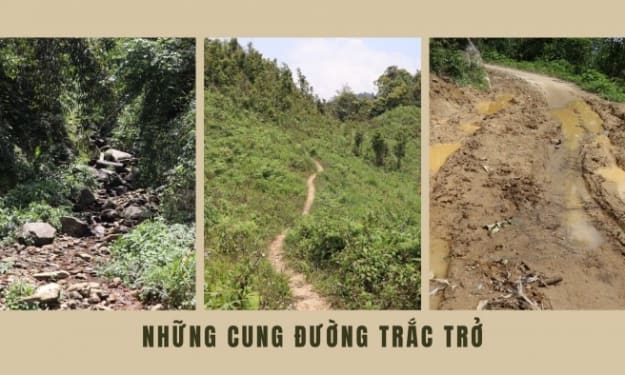The Dreams of Children in Highland Areas
Born and raised where the sky meets the forest, surrounded by mountains, one might think that the lives of children in highland areas would revolve only around farming, tending to the kitchen, and struggling to make a living... But hidden deep within each bright pair of eyes is the desire to escape poverty, the thirst for knowledge, the aspiration to become teachers, doctors, skilled chefs... and to help uplift their own homeland.

More than just deprivation
Arriving at Buoc village, Thanh Son commune (Quan Hoa) on a late winter day, we couldn't help but feel saddened as we often encountered boys herding black buffalo with bare feet, calloused early due to rocky terrain, without hats or caps... and ethnic minority girls carrying firewood on their backs. Though accustomed to the harsh weather of the high mountains, every gust of wind made these small bodies shiver with cold, their skin turning pale.
It was quite difficult, but we managed to strike up a conversation with 8-year-old Ha Thi Lan, partly because she was shy around strangers, partly because the bundle of firewood was too big, making it difficult for her to change positions. When she got too tired, she finally set the bundle down, panting heavily, and shyly explained: "Every day after school, I go to the forest with my parents, sometimes to collect firewood, sometimes to till the land." When asked about her dreams, Lan said innocently: "I want to be a teacher, like our teacher. Our teacher said if we study well, she'll take us to the city to play. Many kids in my class have never been to the city, never played on swings, inflatable houses..." After saying this, as if remembering something, Lan quickly put the bundle of firewood on her back and hurried away. In a blink of an eye, her small, swaying figure disappeared behind the trees.
Leaving Quan Hoa district, we climbed up to Muong Lat district. Despite being midday on a Sunday, many houses were deserted, devoid of children. "They've all gone with their parents to the fields. It's cassava season," said teacher Ho Po Sung from Pu Nhi commune, pointing towards the distant mountains. Making our way to the cassava fields halfway up the mountain, I sat down, panting. There, I met Sung A Thao (9 years old), Giang A Do (10 years old), Vi Van Phuc (10 years old), all from Pu Toong village, each holding a hoe digging up the remaining cassava tubers after harvest.
As the sun began to set, the children poured out their cassava to compare who had dug up more. I estimated each of them dug up about 3-4 kg. With cassava priced at a few thousand dong per kg, each child could earn tens of thousands of dong. According to Giang A Do, they were neighbors and attended the same school. Taking advantage of weekends off school, the kids went to dig cassava to buy books, toys...
Children in the highlands are aware of their living conditions, so even though they are younger than city children, their thoughts about food and clothing are very mature. Many of them go to school but still worry about who will fetch grass for the buffalo to eat at home? Who will carry their younger siblings while their mother goes to the fields? Who will scoop rice to bring to school?... Such thoughts alone are enough to make their steps hesitant before the written word, not to mention the treacherous paths they have to traverse through forests, over passes, and across streams to get to school. Therefore, in the new school year, many teachers have to work hard, going to each house to persuade students to come to class, because the teachers know that though the written word may be small, it is useful for the children, helping them to have a brighter future.
From Pu Nhi commune, we went to Muong Ly commune. In the dilapidated house in Sai Khao village, Vang A Do - a 25-year-old father with three children - was anxiously waiting for his 10-year-old daughter to return from cutting grass for the buffalo to cook rice. The young Hmong man sighed: "Our family is poor, so the children have to work. At 8 years old, she has to go herd buffalo. Normally, besides attending school, she goes to herd buffalo, but during corn and cassava seasons, she has to go husk corn, dig cassava in the fields."
As the sun flickered, the little girl carried a bundle of grass down from the mountain. As soon as she entered the house, she put the kettle on and went to rinse the rice. I was surprised to see this little girl expertly handle the heavy pot of rice, as agile and resilient as an adult.
Mr. Vang A Le, head of Sai Khao village, said: "Sai Khao has over 97 households, 100% of which are ethnic Hmong people. 80% of them are poor households, the rest are near-poor, so getting children to school is already an effort for the villagers, not to mention the care and encouragement for the children's education at home. Therefore, the children learn as much as they can."
To bring warmth to spring
Children in the highlands love spring. Because when spring comes, there are festivals, markets are busier, and the weather is less bitterly cold. This is also the season when many volunteer groups "bring spring" to remote villages where food and clothing are scarce. Such volunteer groups are often called "good people from below" by highland children because they receive gifts from them. The sight of young people wearing warm clothes for the little ones on windy, cold days touches many hearts.
During these volunteer trips, the "good people from below" often ask highland children: "What are your dreams?" And the answers vary: "I wish for new clothes"; "I dream of going to school with my friends!"; "I wish for electric lights!"... These dreams may be small and simple, but they pose big challenges for government agencies and society as a whole.
According to Mr. Truong Van Binh, Head of the Department of Labor - Invalids and Social Affairs of Muong Lat district, about 50% of households in the district are poor or near-poor. Particularly, areas with concentrated ethnic minority populations face extreme difficulties. Many children work in the fields while attending school. In previous years, there was a situation where children aged 11-15 went to cities like Hanoi, Ho Chi Minh City to work as laborers, and the district had to send people to bring them back. Finding effective solutions to improve the lives of children in areas with concentrated ethnic minority populations remains a challenge. Therefore, the state needs more policies and investments to support these areas, aiming to improve living standards and reduce the aforementioned situations.
It must be said that the "good people from below" have reached out to these children more than before, making their presence more tangible. Charitable programs such as "Warm Clothes for Children", "Lighting up Dreams", "For Highland Children", or volunteer tourism trips by many students, travel groups... have somewhat brought smiles to the faces of highland children. Every year, dozens of organizations, centers, and charitable funds make efforts to help and share with the impoverished lives of people in highland and ethnic minority areas, especially children. However, all these efforts are still like drops in the ocean. Somewhere in the deep mountains and valleys, in remote border areas, there are still destinies, life situations, unfortunate children who have never been noticed, who have never experienced the kindness of people from below.
We need more than just "meals with meat", "feet with shoes", "backs with shirts"... We all need to join hands to improve the quality of.
About the Creator
Enjoyed the story? Support the Creator.
Subscribe for free to receive all their stories in your feed. You could also pledge your support or give them a one-off tip, letting them know you appreciate their work.





Comments (1)
https://amzn.to/3vLjjpN